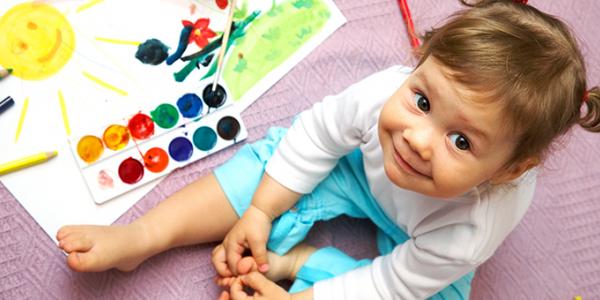Meaningful Art Projects Parents Can Fit Into a Busy Day

You are here
By Richard Rende, Ph.D.
Art projects offer children and families many benefits. Child development and pediatrics experts agree that even short spurts of creative time greatly impact social, cognitive, and emotional development of children in their earliest formal years and create long-lasting memories. It’s important to remember that a meaningful art project doesn’t need to take a lot of parent preparation time.
Here are a few tips to help busy families engage in meaningful art projects.
1. Eliminate the pressures that make art projects difficult
Art projects don’t need to take a lot of parent prep time. Use items that you already have around the house – like paper towel rolls or cotton balls – to eliminate time needed to go to the store and purchase special supplies. And keep staple items on-hand that can be used for a variety of art projects - such as paper, paint, tape, crayons, and glue. You can take them out and add in other items you have to the mix.
2. Let children take the creative lead
Parents promote creativity, thinking, planning and other important skills when they let kids take the lead on art projects. The creative spark is lit when kids try to figure out how things work on their own.
A number of recent studies have shown that young children display more advanced cognitive skills when adults use less instruction. One of the key reasons is that this allows kids to practice what’s known as “counterfactual” reasoning, the process of mental “trial and error” that is an early emerging aspect of innovative thinking. For example, ‘What happens if I paste this piece of fabric here instead of there?’ or ‘What if I paint this dog green?’ By hanging back and encouraging kids to try out their own ideas versus giving a strict pattern to follow, parents can support the roots of innovation.
3. Allow children to use their hands to create their project
Art projects also offer many ways for children to build their small muscles and improve their fine motor development. When children use scissors, squeeze a glue bottle or mold clay they strengthen the muscles needed to master using a pencil at school later on.
4. Support but don’t take over
The benefits from doing art projects independently are critical for academic readiness.
Parents can support their children by encouraging them, helping with suggestion, and stepping in only when really needed. While it might take your child longer to open a glue bottle or paint tube, these are important ways children can develop the muscles they will need for school.
5. Praise their efforts, not the product itself
It’s clear from research that praising children for their effort, not the quality of the final product, supports the future mindsets that underlie success in academics, sports, and arts.
Art projects offer a perfect platform for encouraging and reinforcing effort rather than focusing on outcome.
For example, parents can acknowledge something specific a child spent time on like making a particularly interesting color when mixing paints or acknowledging a specific skill like cutting with scissors instead of focusing on how the final project looks.
6. Remember – you’re creating happy memories
The fact that you’re supporting your child’s creativity and spending time together is important. One of the most important benefits children and parents both reap from arts and crafts is that, years from now, it won’t matter what was created, just that it was created as children and parents spent time together.
Interesting materials, smiles, laughs, and some silliness keep kids engaged. Not only will this lead to cognitive benefits, but also bonding time with parents. Kids will form lasting memories that will stay with them for years to come.
Richard Rende, PhD is a developmental psychologist, researcher, author, and educator. He recently teamed up with Elmer’s to further explore the impact of creative time on our children’s long-term success and through this research, found the majority of those surveyed wished they had more time to engage in arts and crafts with their children.